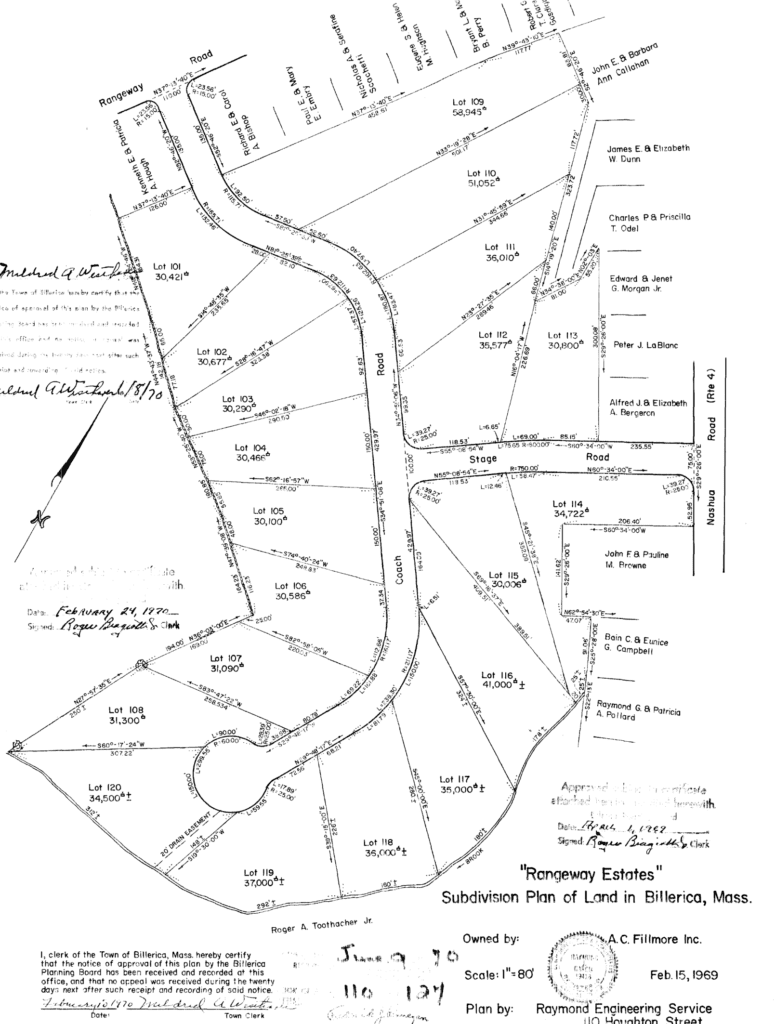Multiple times a month, I get a call from a seller with the question, can I subdivide my land?

They have a large lot and think there is a buildable lot or lots that can be cut out of their tract of land.
Here in the greater Boston area, a lot that can be built on is scarce, so if you are sitting on a lot that can be built upon, it can be turned into cash.
Depending on the circumstances it can be a very simple process to extremely complicated to determine if your land can be subdivided.
Because of the high cost of lots for new construction homes, it is certainly worth a little effort to see if your land can be divided into one or more building lots.
Here are points to bear in mind along the way that will help you make the decision about where to head with the possibility of subdividing your land.
What Is Subdividing Land?
Subdividing land is simply taking one parcel of land and dividing it into one or more separate parcels of land. Currently, you may have one 5-acre lot with a house and you believe you can subdivide your land to have two separate deed lots with a lot remaining for the current house.
Of course, it gets a bit more complicated there are state and local laws governing whether you can create a subdivision from your current parcel of land.
Why Would Someone Want To Subdivide A Piece of Land?
There is a couple of reasons why someone would want to subdivide a tract of land.
Cash!! In high-cost areas that extra land can be converted into lots of cash if one or more buildable lots can be carved out of the original parcel.
The other reason we see owners wanting to subdivide is to gift a piece of land for an adult child or other family to build upon to keep them nearby.
The key here is when you carve out another lot or lots out of the original parcel you get a buildable lot or lots out of the division of land. That is where the money is. An unbuildable lot while not completely worthless is generally not worth going through the effort.
ANR, Form A and Conforming Lots

If you have a lot that conforms with all the Massachusetts town zoning for a individual lot, it is called a Form A, ANR (approval not required) or conforming lot. A “Form A” lot technically requires no approval, though you will still have to go in front of the planning board. If you are lucky enough to have one or more ANR lots the process is pretty simple and may not cost a bundle of money to accomplish.
As long as you meet the requirements they have no basis to deny the division of your land. An ANR lot or lots must meet the town zoning requirements as follows:
- Required road frontage.
- Minimum size requirements met.
- The original lot was not non-conforming.
Subdivision Plan
ANR lots are already on a public way and conform to all current zoning laws for the area and the process is simple.\
But what if you have a large parcel of land that you think you can get multiple lots on but there isn’t enough public road frontage?
You are now talking about a subdivision plan with a proposed road or roads. This is definitely more complicated with a lot of moving pieces. You are talking about surveyors, engineers, wetland studies, approval, etc….
While it certainly can be done, it will take time, money and resources to complete.
How To Subdivide Land
If you really have an inkling you would like to sell off some land to a builder for a subdivision or a single building lot, a REALTOR with experience in subdividing land will work with you to do all this upfront research. But if you would like to do some research on your own, start with going to your town website or go right to the town hall.
- Start with the Zoning department and see if you can get a plot plan and find out where the property is located on the zoning map and what the requirements are for that particular zone. Just because you don’t have a Form A lot doesn’t mean you can’t get a variance.
- Head over to conservation and see if there are wetlands are on your property. Conservation will give you a rough idea if there are or aren’t wetlands to contend with. Either way a wetlands assessment will need to be done.
- If all looks good head over to the planning board. The planning board will give you an idea of what may be possible and what hurdles you may have ahead of you.
Pay Attention To Easements and Right of Ways
Easement and right of ways can impact the value of the land. Many easements run with the land. You can not just nullify an easement. An easement is a right for another to have a certain use of your land and may impact how you use the land.
Determine if there are any easements that might impact the value of the resulting lots. Check your deed and see if it makes reference to any easements and where they may cross your land.
The Building Envelope
Now that you have an approved lot the big question is what can you build on it. The building envelope determines what area on the lot you can build on. A lot will have minimum front, rear and side setbacks.
Your setback from lot lines is very easy to determine from zoning bylaws. The difficulty is determining if your property has wetlands or not. Wetlands can severely impact your building envelope. In some cases, your building envelope becomes so small that it may be next to impossible to build.
Determining If There Are Wetlands
At some point along your journey if your end goal is to build a home or homes on lots you have created, you will have to contend with wetlands whether it is an ANR lot or an entire subdivision.
Do not make the assumption you have no or have “wetlands” on the property. Just because the land is soggy or there is a puddle of water doesn’t mean you have wetlands on your property. And, if there are no signs of water on the property it doesn’t mean there aren’t wetlands.
Wetlands are complicated. Wetlands are an important part of our environment and your local government will want to protect them. At some point, you will have to hire a professional to identify and delineate wetlands on your land.
Check with your Conservation Department about what will be required for your project to get conservation approval.
Some Thoughts on Selling Your Land to Subdivide
So I just gave you a quick, really simplified overview of subdividing your land. It can be quite complicated and can get quite expensive if you are talking about multiple lots with a road for a subdivision. There will be a decision that will be made once you feel that you have land that is sub-dividable:
Decide to subdivide the land yourself
You need time money and patience. This means hiring surveyors, an engineer, a botanist, an attorney, etc… to prepare the documents and subdivision plan you will need to present to the town for approval. The farther you bring a project down the road the more money it will be worth.
The Cost Of Subdividing Your Land
On simple conforming lot it could run you several thousands of dollars for a surveyor and a plan to upwards of $25,000 to 80,000 for a more small subdivision. The upshot of going this route is if you are successful you will make more money, you have eliminated the risk for the builder if you are providing a subdivision with permits in hand or the guarantee of permits.
The con is you can spend all of this money to fall flat on your face and lose all your development costs, you take the risk. The higher the risk the greater the reward.
Decide to sell the land raw and let the builder subdivide subject to…
Most homeowners will opt to go this route. They will sell the land as raw land subject to final approval from the town. Meaning a builder will agree on a certain amount and put down a deposit.
The builder will have a contingency clause in the contract saying that the sale is subject to final town approval and permits on a….. certain type of building, number of buildings, etc…
The benefit for you is you are taking no financial risk, the builder will carry the risk. The cons of going this route are you will have to wait anywhere from 6-18 months for final town approval depending on the project and you will get paid less for the land.
The farther you bring the land into development the more money you can make.
What is My Land Worth If I Subdivide?
This is the million-dollar question. It is hard to give you a hard and fast rule so I will give you a ballpark rule that will give you a rough idea. The money is in having a lot to build on. If a lot is unbuildable it may not hold much value.
Typically a builder will pay around 1/4 to 1/3 the cost of the new home that can be put on an approved and permitted lot. Meaning there is no extensive engineering or permitting process. So for example, if the lot can handle a finished house selling for $800,000 dollars they may be willing to pay around $200,000 to $270,00 per lot.
Please remember this is just a simple formula to get you into the ballpark of what your land could be worth. It is certainly not written in stone.
There are many other factors involved including the length of the driveway, how far a builder may have to go to connect to sewer and water, or if a septic system or a wel is needed, plus any other number of variables that will increase the cost to build a specific location.
For example, our MLS is filled with large tracts of land, with tons of acreage, where you can put maybe two possibly three houses but it requires an 800-foot road going over wetlands just to get to those buildable lots. It could cost $400-$1000 a foot to build the road.
So just to get a road in you are talking the builder needs to spend $320,000 to $640,000 just to build a road for two houses. In many moderate to lower-priced towns where a builder might only pay $150,000 for a conforming lot this makes the project unfeasible.
If the lot is not approved and ready to go then a builder will start subtracting the costs from there. If they have to do engineering, rip down an existing structure, build a road, they need to factor in the cost of each item from the maximum that would be willing to pay for a lot approved and permitted.
For example, I had a piece of land I recently sold. We estimated that a builder could get four lots, one would be an existing structure that would be rehabbed, on about a 4-acre parcel of land.
There were a lot of wetlands to contend with. The finished houses were worth about $2,250,000 combined sold to the end buyer. We take that $2,250,000 and divide by 3 and we get $750,000 dollars. There would be roughly $90,000 in legal and engineering than about $160,000 in building a road with a cul-de-sac.
This brought the land basis down to about $500,000 ( ultimately we added $75,000 more for the existing house, the cost of rehab was far less than new construction). We had builders with competing offers and it sold for just around that amount.
Final Thoughts On Subdividing Your Land
Subdividing your land can be complicated. Just because you own a large parcel of land does not mean it is subdividable or even worth doing. If you have no clue where to start contact a local real estate agent . They will at least be a starting point to see if it is worth pursuing subdividing your land.
While it can be a lot of research, work and sometimes money, it can also put a lot of money in your pocket if it can be done.
Other Real Estate Resources
Buying a new construction home can be significantly different than a resale home. Often you don’t see the finished product and are making decisions based on plans, renderings and if your lucky a model home. Bill Gassett provides some great advice for buying a new construction home.
Buying land and building a home is definitely more complicated than one may think. It’s not as simple as getting a mortgage for a resale loan. Often banks will want you to pay cash for the land and then they will lend money to build in the form of a construction loan. Joe Boylan gives some great advice on buying land to build on.
When subdividing land a survey will be required with a plat map. A plat map is a detailed drawing showing your subdivision boundaries, nearby streets, easements, dimensions and more…..
_________________________________________________________________
This article, Subdivide Your Land, was provided by Kevin Vitali- 978-360-0422. If you think you have land that can be subdivided, is a possible building lot, or you have a home that could be a tear down for new construction, call me. I can start the research to see if we have a building lot or lots for you to sell.




